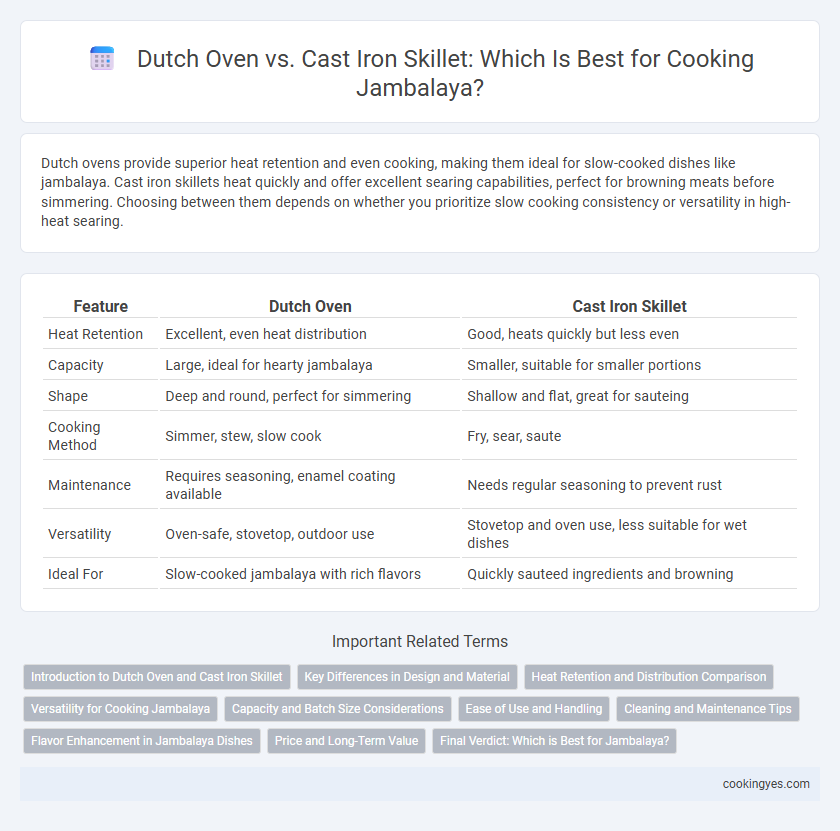Dutch ovens provide superior heat retention and even cooking, making them ideal for slow-cooked dishes like jambalaya. Cast iron skillets heat quickly and offer excellent searing capabilities, perfect for browning meats before simmering. Choosing between them depends on whether you prioritize slow cooking consistency or versatility in high-heat searing.
Table of Comparison
| Feature | Dutch Oven | Cast Iron Skillet |
|---|---|---|
| Heat Retention | Excellent, even heat distribution | Good, heats quickly but less even |
| Capacity | Large, ideal for hearty jambalaya | Smaller, suitable for smaller portions |
| Shape | Deep and round, perfect for simmering | Shallow and flat, great for sauteing |
| Cooking Method | Simmer, stew, slow cook | Fry, sear, saute |
| Maintenance | Requires seasoning, enamel coating available | Needs regular seasoning to prevent rust |
| Versatility | Oven-safe, stovetop, outdoor use | Stovetop and oven use, less suitable for wet dishes |
| Ideal For | Slow-cooked jambalaya with rich flavors | Quickly sauteed ingredients and browning |
Introduction to Dutch Oven and Cast Iron Skillet
The Dutch oven, a heavy-duty, thick-walled pot usually made of cast iron, excels at slow-cooking and simmering jambalaya by evenly distributing heat and retaining moisture. Cast iron skillets, known for their versatility and ability to achieve high heat, are ideal for sauteing ingredients and searing meats before combining them in the jambalaya. Both cookware types benefit from excellent heat retention, but the Dutch oven's deep, covered design makes it better suited for the complete cooking process of jambalaya.
Key Differences in Design and Material
Jambalaya cooks differently in a Dutch oven versus a cast iron skillet due to distinct design and material properties. Dutch ovens feature thick walls and a heavy, tight-fitting lid that retains moisture, making them ideal for slow simmering and even heat distribution. Cast iron skillets, with their open tops and flat, wide surface, excel in high-heat searing and sauteing but lack the moisture retention necessary for thorough slow cooking.
Heat Retention and Distribution Comparison
A Dutch oven excels in heat retention and even distribution due to its thick walls and heavy lid, making it ideal for slow-cooked jambalaya that benefits from steady, consistent heat. Cast iron skillets provide excellent heat retention but have a thinner profile, leading to quicker temperature fluctuations and less uniform cooking. For jambalaya requiring long simmer times and moisture retention, a Dutch oven ensures more stable heat and better flavor melding than a cast iron skillet.
Versatility for Cooking Jambalaya
A Dutch oven offers superior versatility for cooking jambalaya due to its deep, heavy construction that evenly distributes heat and retains moisture, essential for slow simmering the rice, meats, and vegetables. Cast iron skillets excel at searing proteins and developing a flavorful crust but lack the capacity to accommodate the liquid amount needed for authentic jambalaya preparation. Using a Dutch oven ensures consistent temperature control and prevents burning, making it the preferred choice for achieving the dish's perfect texture and rich flavor profile.
Capacity and Batch Size Considerations
Dutch ovens offer superior capacity for cooking large batches of jambalaya, typically ranging from 5 to 7 quarts, accommodating family-sized portions or gatherings. Cast iron skillets generally provide smaller cooking surfaces, ideal for single or smaller servings but may require multiple batches for larger quantities. Selecting a Dutch oven ensures even heat distribution and sufficient volume to simmer jambalaya efficiently without overcrowding, while cast iron skillets excel in browning ingredients before transferring to larger pots.
Ease of Use and Handling
A Dutch oven offers superior heat retention and even cooking, making it ideal for simmering jambalaya evenly without constant stirring. Its heavy lid and deep sides reduce splatter and allow for easy lid handling when using oven mitts. A cast iron skillet provides greater maneuverability and quicker heating but requires more frequent monitoring to prevent uneven cooking or burning during jambalaya preparation.
Cleaning and Maintenance Tips
Cast iron skillets require seasoning after each use to maintain their non-stick surface and prevent rust, making regular oiling and gentle hand washing essential for longevity. Dutch ovens, often coated with enamel, offer easier cleaning since they don't need seasoning and can handle more abrasive scrubbing without damage. Both benefit from drying thoroughly to avoid moisture buildup, but enamel Dutch ovens are generally more forgiving in maintenance compared to raw cast iron skillets.
Flavor Enhancement in Jambalaya Dishes
Dutch ovens provide even heat distribution and moisture retention, which intensifies the deep, rich flavors essential in authentic jambalaya. Cast iron skillets excel at high-heat searing, creating a flavorful crust on meats and vegetables that enhances the dish's complexity. Combining both tools can elevate jambalaya by layering textures and maximizing flavor infusion throughout the cooking process.
Price and Long-Term Value
Dutch ovens typically offer higher upfront costs, ranging from $60 to $200, but their superior heat retention and versatile cooking capabilities provide exceptional long-term value for making jambalaya. Cast iron skillets are generally more affordable, priced between $20 and $50, and deliver excellent searing and even heat distribution, though they may require additional cookware to handle larger portions. Investing in a Dutch oven ensures durability and multi-functionality, making it a cost-effective choice for consistent jambalaya preparation over time.
Final Verdict: Which is Best for Jambalaya?
The Dutch Oven offers superior heat retention and even cooking, making it ideal for slow-simmered jambalaya where flavors meld perfectly. A Cast Iron Skillet excels in high-heat searing and browning but may lack the depth and capacity for simmering large batches. For authentic jambalaya preparation, the Dutch Oven provides the best balance of heat control and volume, ensuring a rich, well-cooked dish every time.
Dutch Oven vs Cast Iron Skillet for cookware Infographic

 cookingyes.com
cookingyes.com